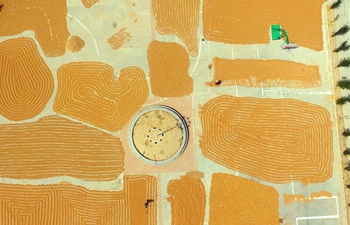WASHINGTON, June 7 (Xinhua) -- The United States space agency NASA's Curiosity rover has found new evidence preserved in rocks on Mars that suggests the planet could have supported ancient life, and new evidence in the Martian atmosphere that relates to the search for current life on the Red Planet.
The new findings, reported on Thursday in the journal Science, are organic molecules in three-billion-year-old sedimentary rocks near the surface, and seasonal variations in the levels of methane in the atmosphere.
They are not necessarily evidence of life itself, but a good sign for future missions exploring the planet's surface and subsurface, according to the study.
Organic molecules contain carbon and hydrogen, and also may include oxygen, nitrogen and other elements. Although commonly associated with life, organic molecules can also be created by non-biological processes.
"Curiosity has not determined the source of the organic molecules," said Jen Eigenbrode of NASA's Goddard Space Flight Center who is lead author of one of the two new Science papers.
"Whether it holds a record of ancient life, was food for life, or has existed in the absence of life, organic matter in Martian materials holds chemical clues to planetary conditions and processes," said Eigenbrode.
Data from Curiosity revealed that billions of years ago, a water lake inside Gale Crater held all the ingredients necessary for life, including chemical building blocks and energy sources.
"The Martian surface is exposed to radiation from space. Both radiation and harsh chemicals break down organic matter," said Eigenbrode. "Finding ancient organic molecules in the top five centimeters of rock that was deposited when Mars may have been habitable, bodes well for us to learn the story of organic molecules on Mars with future missions that will drill deeper."
To identify organic material in the Martian soil, Curiosity drilled into sedimentary rocks known as mudstone from four areas in Gale Crater. This mudstone gradually formed billions of years ago from silt that accumulated at the bottom of the ancient lake.
The rock samples were analyzed by an oven on the rover which heated the samples in excess of 500 degrees Celsius to release organic molecules from the powdered rock.
A device measured small organic molecules that came off the mudstone sample, finding that some of these fragments contain sulfur, according to Eigenbrode.
Some of the molecules identified included thiophenes, benzene, toluene, and small carbon chains, such as propane or butene.
METHANE IN THE AIR
In the second paper, NASA scientists described the discovery of seasonal variations in methane in the Martian atmosphere over the course of nearly three Mars years, which is nearly six Earth years. This variation was detected by Curiosity's Sample Analysis at Mars instrument suite.
Water-rock chemistry might have generated the methane, but scientists cannot rule out the possibility of biological origins.
Methane previously had been detected in Mars' atmosphere in large, unpredictable plumes.
This new result showed that low levels of methane within Gale Crater repeatedly peak in warm, summer months and drop in the winter every year.
"This is the first time we've seen something repeatable in the methane story, so it offers us a handle in understanding it," said Chris Webster of NASA's Jet Propulsion Laboratory, the lead author of the second paper.
Finding methane in the atmosphere and ancient carbon preserved on the surface gives scientists confidence that NASA's Mars 2020 rover and European Space Agency's ExoMars rover will find even more organics, both on the surface and in the shallow subsurface.



















